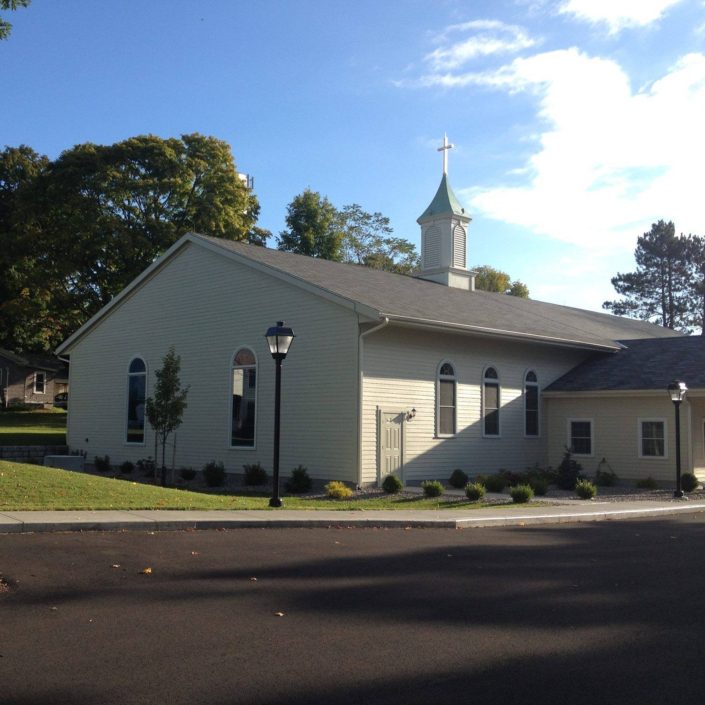
Was Akwesasne’s “Burnt Church” a Sacrifice to Peace?
(Originally published in The People’s Voice, September 9, 2005)
Written by Darren Bonaparte
In his discussion of the founding of the St. Regis Mission in his A History of Franklin and St. Lawrence Counties, New York (1853), historian Franklin B. Hough presented some of the oral traditions he gathered during several visits he made to Akwesasne. One concerned the fate of the first church established here by Father Antoine Gordon, S. J.:
Among the first duties of Gordon was the erection of a church, which was built of logs and covered with barks.
This humble and primitive temple of worship, was made to serve the double purpose of a church and a dwelling, and one end of the hut was partitioned off for the residence of their priest.There being no bell, when the hour of worship arrived, an Indian went through the village from hut to hut, and announced with a loud voice the hour that they might assemble for prayer…
In about two years, this church was burned, and with it the first two years of the parish records.
The first record extant, bears the date Feb. 2, 1762, when Margarita Theretia an Abenaki woman, married, and of unknown parentage, was baptized.
Since that date, the parish records are very perfect, they have been kept in the Latin and French languages.
Soon afterwards a small wooden church was erected on the ground now occupied by the priest’s garden, which was furnished with a small cupola, and contained a bell.
Hough mistakenly assumed that the mission had been established in 1760, when in fact, it had begun five years earlier, although it may have originally looked more like a French military post at first. Hough also concludes that the first church was destroyed by fire sometime before February 2, 1762…the date of the first surviving entry in the parish records.
Oral traditions tell us that when people first came to Akwesasne from Kahnawake, they brought with them relics of Kateri Tekakwitha, which were lost when fire destroyed the church. Hough tells us that the second church constructed where the priest’s garden now lies (which in 1853 may have covered the entire courtyard next to the rectory) but we do not know if it was constructed where the first “bark chapel” once stood. A broken and scorched part of a ceramic statue was found in the garden not long ago, which may very well have been a fixture in that original church.
Hough says very little about the burning of the church, other than that it happened. Since the priest dwelled in the church itself, one might expect a heightened degree of vigilance in its protection, yet its destruction was so complete that even sacred relics like Kateri Tekakwitha’s remains could not be saved from the inferno. Was it a simple accident, or was the fire deliberately set when the priest wasn’t there? Was it set to get him as he slept? And if so…who would have done such a thing?
To answer such questions require us to examine the historical documentation from that time period to see what was going on back then…and if there was anyone who would have wanted the priest and his church to come to harm.
In a letter to General Jeffrey Amherst dated April 4, 1762, Henry Gladwin of the Indian Department reported that the former native allies of the French were having a council to discuss rising up against the British:
Yesterday a Coghanawaga Indian came here, he has often been of use to the Garrison, in which he always found his account, for this reason I though him a proper hand to question about the practices of our Enemies below, he immediately replied he would tell me all he knew, in Substance as follows, That immediately after the reduction of Canada, the Priest of Aguasasnagh made four very large belts, after the Chiefs of that Village had declared they would have no hand in it; that two of these belts were sent to the Northern Indians by St. Luke LeCorn, the other two came this way, and the meaning of them was, that a French fleet, and Army would come over the ensueing spring to retake Canada, that now was their time, to rise and recover their Country; he likewise says, last fall the priest of Aquasasnagh, made the like number of belts as the year before, which were delivered in the same manner, with this difference only, that the Spaniards would joyn the French, and that they were invited to assemble at Frontenac; these belts were sent off just before St. Luke LeCorn took his departure for France; he has likewise given me the names of all the principal promoters of this affair, who are (he says) all equally concerned, I enclose you herewith their Names; Besides these Belts, and the Grand belt that is to be delivered at D’etroit, I have reason to believe from concurring Circumstances, that the Clergy, and their Agents, have sent Messages or belts to all the Indians with whom the French have ever had any Communication; I have prevailed upon my Informer to go to Montreal to tell General Gage what he knows-
My Informer who went to the five Nations some time ago, sent me a letter from thence which came to hand Yesterday, he says the all the Indians that way will rise to a Man to take Oswegatchy
In his letter, Gladwin listed the names of the conspirators, which included a number of priests. Among them is the priest of “Sainte Registe,” though he did not mention his name. The very next day, Gladwin wrote another letter to Amherst to include additional information from his informer.
…he then said, that last fall, St. Luc LeCorne, and the Priest of Aquasasnagh, delivered seven belts to Mosieur Deroche, known among the Indians by Name of Aagistagese (Just before St. Lukes departure for France) that he and four other Canadians, carried them to the Northern Indians, delivered some belts there, afterwards they returned to Montreal by way of Detroit, and thro’ the five Nations, delivering their belts and Messages by the way, and inviting all the Indians to assemble at Frontenac early in Spring, in order to attack Oswegatchy, and harrass the Communication, That a French, and Spanish fleet was coming to retake Canada, and now was their time to rise and recover their Country, he likewise says, as they passed this way, they delivered three belts one to each of the following Nations, Viz- Misisagaoes, Abanaquis, and Oswegatchys, that these belts were accepted by them, but the Coghnawagas, and Conossadagas refused to receive any, he further says that these belts were not made by the Priest of Aquasasnagh they were made under his Eye, by an Abenaquis woman, and by his direction-
Although the priest at St. Regis may not have directed the making of these latter belts, he definitely had a hand in the plot to encourage an insurrection against the British. According to the Kahnawake informant, the chiefs of Akwesasne, Kahnawake, and Kanehsatake wanted nothing to do with this French conspiracy. How far did they go to make sure it did not destroy the peace they had given their word to uphold?
As is often the case, the historical record offers us few answers, and leaves us with even more questions.
Sources:
- Franklin B. Hough, A History of St. Lawrence and Franklin Counties, New York. 1853: 114-115.
- Sir William Johnson Papers, Volume X:422-425.
Next week: Louis Cook: A French and Indian Warrior
By Darren Bonaparte, historian and author of The Wampum Chronicles. Reprinted with permission.
Darren Bonaparte is a cultural historian from the Akwesasne First Nation. He is a frequent lecturer at schools, universities, museums, and historical sites in the United States and Canada. He has written four books, several articles, and the libretto for the McGill Chamber Orchestra’s Aboriginal Visions and Voices. Darren is a former chief of the Mohawk Council of Akwesasne. He is the creator of The Wampum Chronicles and historical advisor to film and television. He currently serves as the Director of the Tribal Historic Preservation Office of the Saint Regis Mohawk Tribe.















 4 Elements Studio ART EXPO 2023. Photo courtesy of 4 Elements Studio.
4 Elements Studio ART EXPO 2023. Photo courtesy of 4 Elements Studio.